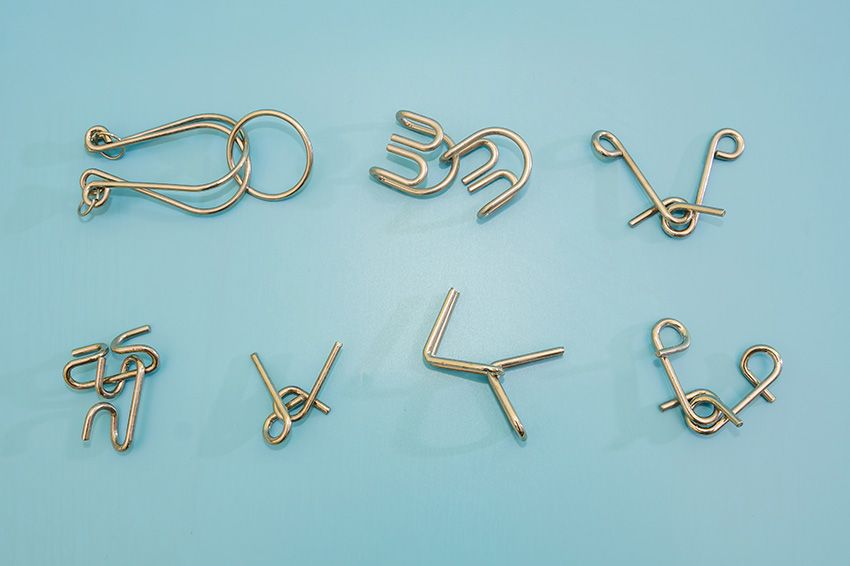Puzzles are seeing a resurgence. Faced with shelter-in-place mandates in early 2020, many people locked inside realized they had limited ways to occupy themselves, so they reached for a childhood staple. The result? A whopping 400% increase in puzzle sales.
The meditative-yet-challenging activity has been helping humans pass time — and manage anxiety, sharpen cognitive skills, and strengthen social bonds, too — for millennia. Here’s the complex history of puzzles.
Early Puzzles Originated in China

About 3,000 years ago, some of the earliest puzzles doubled as practical pieces of pottery. Called “bottom-fill vessels,” these ancient puzzles were basically teapots, but as the name suggests, they were filled from the bottom. The challenge was to learn how to fill the pot with just the right amount of water. Add too much, and all of the water spilled out. Add too little, and you wouldn’t be able to pour yourself a drink.
That wasn’t the only puzzle rocking China. Those who weren’t busy pouring a puzzling pot of tea were often stroking their chins over a tangram, a square puzzle broken into seven shapes. As the story goes, the tangram was invented during the Song dynasty about 1,000 years ago after a glassmaker was hired to make a window for the king. The artisan had built a beautiful and perfectly-square glass window, but when he tried to deliver it to the king, the artisan tripped and the window broke.
Remarkably, the glass broke into seven clean shapes: five triangles, one square, and one parallelogram. Rather than panic, the glassmaker rejoiced at his discovery and one of the world’s most popular puzzles was born.
But the infamous glassmaker wasn’t the first person to break a square into different patterns. A couple of hundred years earlier in Greece, the famed mathematician Archimedes reportedly concocted a similar invention called Ostomachion. The device, which translates to “bone fight,” was designed to help Archimedes figure out some geometry problems. But he soon realized that the 14-piece puzzle could be rearranged to form countless shapes, from elephants to gladiators, which led to endless enjoyment.
Centuries later, professional mathematicians would discover that the simple Ostomachion could be arranged into an impressive 536 different shapes.
Puzzles Make Their Way to Europe

The middle ages — the Bubonic Plague, a lack of indoor plumbing — were a tough time, to put it mildly. So, naturally, a lot of people tried to find a silver lining by having a few drinks and playing a game. Much like the Chinese before them, Europeans scratched their puzzle itch with pottery.
Sometime around the 13th century, puzzle jugs made an appearance. These jugs weren’t ordinary pieces of pottery; rather, the neck was punctured with a series of artistically-carved holes. For puzzle solvers, the goal was to drink or pour from the jug without spilling any liquid through those pesky leak-prone gaps. The puzzle was usually solved by covering just one of the holes, creating a vacuum that made it possible to suck liquid out, like a straw.
But trends would change, and a couple of hundred years later, Europeans were no longer content with puzzling pottery. Instead, they turned their attention to mechanical “disentanglement puzzles.” These puzzles, which involved untangling a fussy knot of strings or chains, were practical inventions first intended as locks. But by the late 1600s, solving them became a pastime unto themselves.
And then the 1760s came, and one man changed everything.
Birth of the Jigsaw Puzzle

John Spilsbury, a London mapmaker, wanted to help children learn their geography, so in the 1760s, he printed a world map and pasted it onto a piece of wood. Then, using a scroll saw, he traced around each country’s border. The result was a so-called “dissected map,” aka the world’s first jigsaw puzzle.
Like Archimedes before him, Spilsbury believed puzzles had educational value. The problem was, he had struck upon such a fun idea that eventually there were thousands of imitators. The dissected maps took on a life of their own and soon depicted everything from nursery rhymes to famous works of art.
The invention of the treadle jigsaw, which allowed for more complex shapes and speedier production, prompted a boom in puzzle-making; German toymaker Ravensburger and America’s Parker Brothers dominated puzzle production.
By the early 20th century, jigsaw puzzles had become the latest obsession. In fact, the New York Times declared in 1908: “The picture-puzzle craze has come to town, and those who are not staying awake nights to fit the puzzles together are using them as a sedative to put them to sleep. For the time being solitaire is forgotten. Millionaires and ministers, lawyers and doctors, military and civil service men have all been inoculated with the new puzzle germ.”
However, despite the craze, early jigsaw puzzles were not easy to come by. In 1908, a wood-cut jigsaw puzzle cost $5. Adjusted for inflation, that’s more than $140 today. It wouldn't be until the heyday of mass production that the puzzle turned from a luxury item to an everyday must-have. By the 1930s, about 10 million puzzles were being manufactured in the United States every week.
And now, as more Americans try to embrace tech-free hobbies, puzzles are again having another moment. It’s believed that by 2024, jigsaw puzzles might be a $730 million industry.
